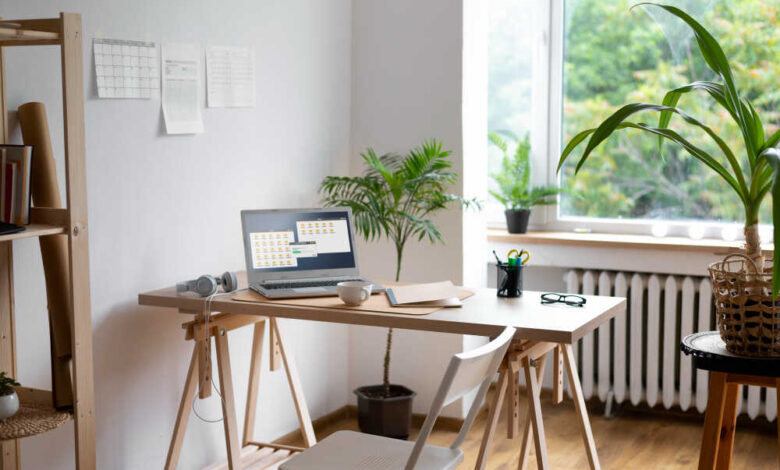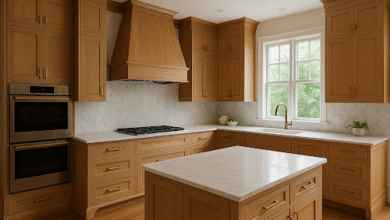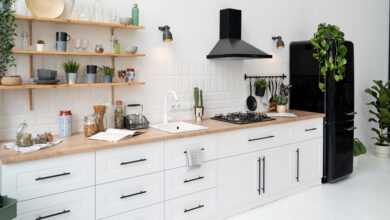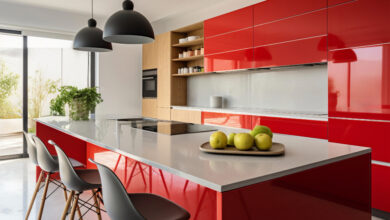The 5 Key Elements to Consider When Crafting Your Home Office

The work landscape is in a state of constant flux, with remote work becoming more prevalent. Much more. Driven by technological advancements, shifting corporate mindsets, and unforeseen worldwide circumstances – like a global pandemic – it’s no longer a passing trend, but an evolving norm.
An integral part of successful remote work is an organized and cozy home workspace. A place where you can feel good and productive. It goes beyond having a mere table and chair at home – it’s about crafting an environment that fosters productivity, aids in balancing your work-life equation, and uplifts your mental wellness. The allure of your couch may be strong, but it hardly promotes long-term concentration or healthy posture.
But how do you succeed with setting up a home office? In this article, we’ll discuss five vital elements to consider when establishing a home workspace that is not only functional but personalized to accommodate your unique working style and needs.
Select an Optimal Location for Your Workspace
Identifying the best location for your workspace is the initial step in your journey toward efficient remote work. This isn’t just about cordoning off a part of your living room for work; it’s about designating a space that truly boosts your productivity and minimizes distractions.
The reason for this? A space specifically marked for work helps your brain connect that area with concentration and productivity. This demarcation is crucial in striking a healthy work-life balance, even within your home’s perimeters.
Firstly, consider the noise levels. Choose a quiet, isolated spot if possible, distant from the busy areas of your house. If complete silence is unachievable, consider noise-canceling headphones or white noise devices to suppress unwanted sounds.
Next, think about the lighting. Natural light is a powerful enhancer of mood and productivity, making a spot near a window ideal. However, don’t underestimate the importance of artificial lighting, particularly during the later hours. A well-illuminated room can help minimize eye strain and sustain your energy levels throughout the day.
Privacy is another critical aspect. It’s crucial to have a space where you can partake in video conferences or concentrate on your work without continuous interruptions.
Invest in Ergonomic and Comfy Furniture
After you’ve found the perfect location for your workspace, the next move is to equip it with ergonomic and comfortable furniture. The role of ergonomics in a workspace is paramount. Since you’ll be spending a substantial part of your day here, your choice of furniture can significantly affect your overall health and physical comfort.
Ergonomics is all about shaping your workspace to support your body’s natural posture and reduce the risk of strain or injury. A badly designed workspace can cause various issues, including backache, neck tension, and repetitive strain injuries, all of which can drastically impact your productivity and quality of life.
Start with the essentials: your chair and desk. An ergonomically designed chair should offer good lumbar support, armrests, and the ability to swivel and roll. It should also be adjustable, allowing you to sit with your feet flat on the ground and your knees at a right angle. Combine this with an adjustable desk that lets you work comfortably, regardless of whether you’re seated or standing.
The same applies to your keyboard setup. Your keyboard and mouse should be positioned such that your arms are at a right angle when typing, with your wrists in a neutral, flat position.
Opt for the Right Lighting
Lighting, frequently underestimated, is an important component in creating a successful home workspace. Adequate lighting goes beyond merely illuminating your workspace; it saves your eye health, uplifts your mood, and can dramatically boost your productivity.
Natural light is an incredible asset. It minimizes eye strain by providing a soft, ambient lighting atmosphere, and it also offers physiological benefits. Daylight exposure can help regulate sleep cycles, improve mood, and even enhance cognitive performance. Therefore, if feasible, place your workspace near a window to enjoy daylight. You will undoubtedly appreciate the decision.
However, relying solely on natural light is not always possible, particularly during late working hours or on cloudy days. This is when artificial lighting comes into the picture.
Consider a blend of ambient, task, and accent lighting. Ambient lighting offers general illumination, while task lighting, such as a desk lamp, provides focused light for specific tasks, minimizing eye strain when reading or writing.
Lighting in your home workspace isn’t merely about visibility; it’s about shaping a space that promotes productivity and comfort. By strategically combining natural and artificial light, you can brighten your workspace while also safeguarding your physical and mental well-being.
Essential Technology and Equipment
In this digital era, the appropriate technology and equipment form the absolute bedrock of any home workspace. Depending on your field of work, the tech tools you require will differ, but there are certain universals that are essential.
Computers, whether desktop or laptop, are a given.
But beyond that, consider other gear that can facilitate your job. This could include a second monitor for increased productivity, a high-quality webcam for video meetings, a printer, or specialized tools like graphics tablets for designers.
A dependable internet connection is non-negotiable. Simply put, when working remotely, your internet connection is your lifeline. It’s worth investing in high-speed internet to ensure uninterrupted video calls, swift uploads, and downloads, and work free of disruptions. It’s also sensible to have a backup option, like a mobile hotspot, to prevent work disruption during unexpected outages.
While it may be tempting to skimp on tech to save costs, remember that high-quality, reliable equipment is a worthwhile investment. Lower-quality tech might save you some money in the short term, but it can cost more in the long run with frequent replacements, repairs, and lost productivity due to downtime.
Often, you can even deduct expenses on tech investments, making it even more reasonable to invest in quality accessories.
Personalization in Order to Maintain Work-Life Balance
Personalization and work-life balance are two crucial, yet frequently overlooked aspects of creating a successful home workspace. When crafting your workspace, remember it’s not merely a place where you work; it should also be a space where you feel at home while working.
Making your workspace truly yours involves adding items that make you feel comfortable and happy, such as photographs or artwork. These personal touches can make your workspace feel less clinical, more unique, and more inspiring.
Your workspace should also encourage productivity and creativity. One way to achieve this is by incorporating plants. Plants not only enhance the aesthetic appeal of your workspace but also have proven benefits for mental well-being and productivity. Studies show they can reduce stress, boost focus, and even improve air quality.*
Artwork can have a similar effect. Hang a painting, display a sculpture, or even add a vibrant rug.
However, the more personal the workspace, the blurrier the lines between work and personal life can become. Without a physical separation between your workspace and personal space, work can encroach on your personal life and vice versa, leading to overworking, burnout, and blurred boundaries.
Defining boundaries is vital. Attempt to establish a schedule and adhere to it. Begin and end your workday at a specific time, as you would in a physical office. Refrain from working outside these hours to maintain a clear distinction between work and personal time.
Keeping a routine can also assist in establishing these boundaries. Dress for work, take regular breaks, eat lunch away from your desk, and when your workday ends, shut down your computer and step away from your workspace.
Incorporating elements of personalization and maintaining a work-life balance isn’t solely about beautifying your workspace. It’s about creating a positive work environment that motivates you, enhances your productivity, and keeps you physically and mentally fit.
Therefore, spend the time to design a workspace that isn’t just functional, but also a place that you love. After all, your home workspace is a reflection of you, and it should cater to your needs as you navigate the world of remote work.




